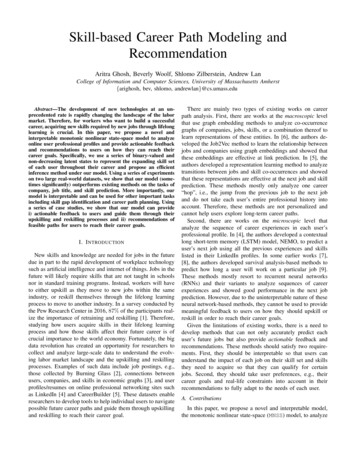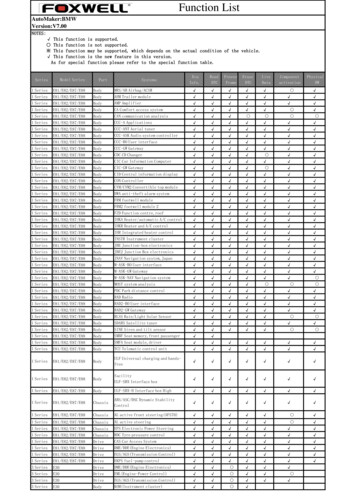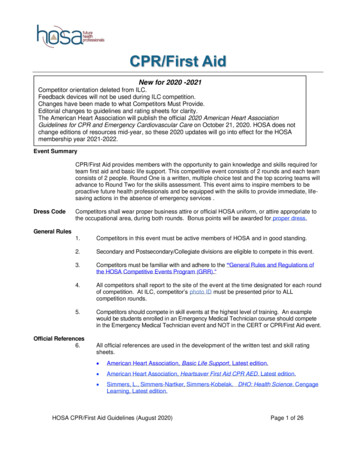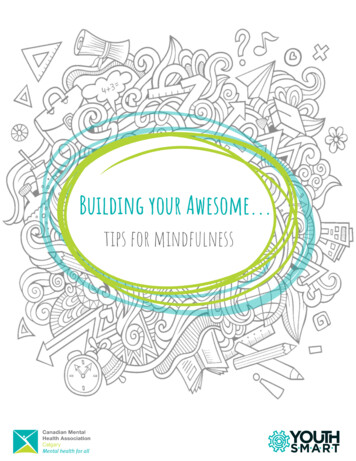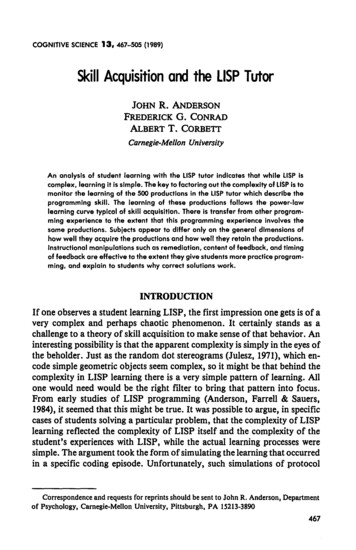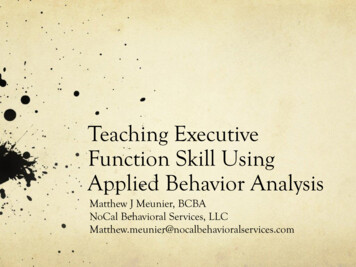
Transcription
Teaching ExecutiveFunction Skill UsingApplied Behavior AnalysisMatthew J Meunier, BCBANoCal Behavioral Services, LLCMatthew.meunier@nocalbehavioralservices.com
What is ABA?
Misconception about ABA
Common Misconceptionsabout Behavior AnalysisRelies on punishmentUses bribesRuins “intrinsic motivation”Ignores the “real causes” of behavior just treats thesymptomsLeads to people controlling each otherIs only used with special needs individuals
What is Behavior Analysis?Behavior analysis is the scientific study of behavior.Behavior analysts ask "Why does behavior changeover time?" They seek answers by looking at thebiological and environmental factors, although theyare primarily interested in the role of environment inbehavior change.
Scientific Study of BehaviorBehavior itself is the focusFocus is not on emotions, thoughts, feelings, dreams,etc.Looks to environment for causes of behaviorCause of behavior does not lie inside of the personSpecializes in changing behavior and teaching skills toenhance quality of lifeNot just problem behavior reduction
Why is it Called BehaviorAnalysis?The term "behavior analysis" was coined by B. F.Skinner, generally considered the founder ofbehavior analysis. The term was meant todistinguish the field as one that focuses onbehavior as a subject in its own right, rather thanas an index or manifestation of somethinghappening at some other level (in the mind,brain, psyche, etc.).
Field of Behavior AnalysisThe field of Behavior Analysis grew out of thescientific study of principles of learning andbehavior. It has two main branches: experimentaland applied behavior analysis.The experimental analysis of behavior (EAB)This literature provides the scientific foundation forapplied behavior analysis (ABA).
Applied Behavior AnalysisApplied Behavior Analysis (ABA) is the applicationof the principles of learning and motivation fromBehavior AnalysisApplied behavior analysis is the process ofsystematically applying interventions based upon theprinciples of learning theory to improve sociallysignificant behaviors to a meaningful degree, and todemonstrate that the interventions employed areresponsible for the improvement in behavior (Baer,Wolf & Risley, 1968; Sulzer-Azaroff & Mayer, 1991).
What is ABA? (Cont.)ABA is representational of a clear and systematic way todescribe, observe, & measure behaviorABA is a science that uses very specific information aboutbehavior to choose interventions to improve sociallysignificant behaviorABA is a research-based (or evidence-based)ABA is based on applied & functional goalsABA is involves data-driven assessment & intervention
What is ABA (Cont.)ABA is supportive of an individualized approach toaddressing strengths & weaknesses of individualsABA is focused on increasing maintenance, generalization,& independenceABA is a set of tools, the specific combination of which isdetermined based upon individual needs
Autism andDevelopmentaldisabilitiesBusiness and industryMental illnessChildmanagement/parentingEducation and unity psychologyHealth psychology andbehavioral lf-management
What ABA is NotABA is NOT a specific method for treatingautism or other developmental disordersABA is NOT equivalent to any one strategyfollowing ABA principles (e.g., DiscreteTrial Training (DTT), Verbal BehaviorAnalysis (VBA)ABA does NOT increase dependence onothersABA research is NOT invalidated due to thefocus on one child at a time (single casestudy)
What ABA is Not (Cont.)ABA is NOT only used for behavior reductionABA is NOT based on aversives (punishment)ABA is NOT based on manipulating peopleABA is NOT exclusive to the treatment of autism
What is Executive Function?“Chief operatingsystem” located in theprefrontal region of thebrain, which is toengage in cognitiveprocesses required forgoal-directed behavior.”(Flexible and Focused, Najdowski 2017)Working memoryTask initiationSustained Problem Solving
What is Executive Function?(cont.)Everything you do every day tomanage your own behavior
Real Life ExampleMaking an appointmentScheduling (planning)What needs to be done priorto appointment(organization)How will it take to get to theappointment (timemanagement)Alarm goes off day ofappointment (task initiation)Remember what youplanned and organized(working memory)Stay focused on task(sustained attention)Avoid checking Facebook(inhibition)Spill your coffee and don’thave time to stop (problemsolving & flexibility)
AssessingThe Behavior Rating Inventory of Executive Function(BRIEF) age range 12-AdultThe Metacognitive Awareness System (MetaCOG)The Executive Skills Questionnaire (ESQ)
Key ABA ngGeneralizationstrategies, etc.Fading
Understanding BehaviorAll people’s behaviors are maintained by eithergaining access to something they likeORAvoid something they don’t want to do
Positive ReinforcementDefinitionStrengthening of behaviorby providing access to ahighly preferred item oractivity contingent uponthe behaviorVerbal praise should be pair ifyou are using tangiblereinforcerReinforcers changeWhat is reinforcing to youmay not be reinforcing to meProvide reinforcers in all areasof teaching new skills
PromptingPromptingPromptingFull physicalShadowingPartial physicalDevices (timers, apps)ModelGesturalLeading Questions (“Whatwould happen if I triedthat?”)Full echoicExperiential Prompt (Try it)Partial EchoicVisual aidsDirective
Prompt FadingPrompt dependentThey will not answer orcomplete tasks withoutpromptsFade out prompts asquickly as possibleAt the start of teaching willrequire more assistancePrompt fadingAs fast as possible withoutmaking mistakesThink about what you useas promptsMost difficult prompt tofade is verbal
ChainingDefinitionooTeaching individual stepsto a taskDevelop list of stepsrequired to complete thetaskForward ChainingoTeaching the first stepoIndependence only onthat stepoAdd new steps as theymasterBackward ChainingTotal Task ChainingoStart with last stepoWorking on all stepsoAll other steps arepromptedoPrompt and fade for steps
What type of chaining?If task needs to becompleted no matterwhat (i.e. morningtime routine)If task does not need tocompleted (problem solving)oForward ChainingTotal task chainingoBackwardsChainingoLearners withenduranceNot good with learners:oFrustratedoAttending issues
Self-AwarenessNoticing your own behaviorsThings your good atThings you struggle with
Self AwarenessLearners who can’t do this:ooMay not notice socialtaboosWithdrawal of friendsLearners who engage inself awareness:Understand socialramificationoBullyingCan make improvements toown behavioroMade fun ofLong term social successoSocially Awkward
Common BehaviorsLearners with difficulty in selfawareness, inhibition and selfmanagement:oUnaware of personalstrengths and weaknessesoUnaware of behavior thatannoy othersoActs on impulsesoNail bitingoTalk too loudoCan’t stop self frombehaviorsoCan’t disengage inproblem behaviors wheninstructed to stop
Self-Awareness WorksheetThings I am good at:Things I do that make me happy:Things I do that make my parents happy:Something I want to learn to do:Things I could improve upon:Personal Goals:
Self Awareness1.Self awareness worksheet1.Fill out worksheet2.Identify behaviors todecrease2.Licking lips, picking nails,blurting out3.Identify behaviors toincrease3.Turning in homework,doing chores4.Identify how strengths canbe used4.Identify personal strengths5.Avoid negatives6.Possible goals (helpful SelfManagement)5.Be positive6.Identify goals
Self-Management1.Identify target behaviorUse worksheet selfawarenessi.2.3.Take baseline dataFrequencyDurationi.ii.1)Decreasing Behavior2)Increasing BehaviorTake Averageiii.i.Frequencyii.Durationiii.% of sessionSet a goali.ii.4.Identify a Reinforceri.5.ShadowingTeach self evaluationi.ii.7.Ask learnerTeach self-monitoringi.6.AchievableSet up for successCommunicate GoalSelf-deliver R (honestychecks)Make new Goals
Self-Management Data SheetName:Date:Target Behavior:Goal:SessionDateTrackingDid I meet my goal Yes or NoMy reward for meeting my goal:Data
Attention
AttentionOperational DefinitionNoticing important stimuli(things)Events in learnersenvironmentStarts in infancy – babynotices mothers voiceWhy teach it?To help distinguish betweenthings that deserve attentionvs. things that should beignoredDisengage with less importantstimuli
ExampleWhen completing bedtime routineand the learner sees her iPad onher bed, is she able to ignore theiPad?
Attention deficits behaviorsHast difficulty finishingtasksTakes longer time tocomplete taskLeaves little messesaround the houseFocused on unimportantdetailsForgets what they wereabout to say or doDifficulty tasks withmultiple stepsStruggles with sustainedattentionConcentration issuesEasily distractedStruggles with shiftingattentionDifficulties completingtwo tasks same time
Activities to teach attention skillsStimulus orientingoTeach learner to noticeimportant stimulioVisual and auditorySaliencyoTeach learners importantstimulioMain idea of sentencesoAttention from othersDisengagementoDisengaging withunimportant stimulioReinforcement for notengaging
Activities to teach attention skillsShifting attentionTeach engaging in a task andthen switching attention tosalient stimulus for a momentGoal to get back to the task athandExample: Writing in journalbut shift attention todirections up front and backto the writingDivided attentionPaying attention to multiplestimuli at onceWatching a presentationConversation while walkingChoose targets that are reallife for the learner
Morning & Evening RoutinesBaselineMaterialsChecklistsTime to complete taskBreakdownsHow long it really takeslearnerCuing task initiationPromptsAlarm clockShadowingPhone AlarmHand over handTimersVerbalInstructionsRemember need to fade these atsome point
Morning & Evening RoutinesChainingForwardBackwardTotal tasksReinforcementTotal task – are you R afterevery step or entire routineMotivation vs. skillsThicker at first then thin R
Morning/Afternoon/EveningRoutine ChecklistName:Morning RoutineAlarmMonTueTimeL PLAfternoon Routine L PEvening RoutineTaskL LearnerL PWeek of:WedThurPLPLPLPLPLPLPLPLPLPLPLPLPLPLPLPLPLPP ParentFriSatTotal Sun
Homework RoutineFirst figure out if the learner does not understand material, ifso provide extra help.Seek tutoring for the learner because a well run homeworkroutine will deal with this issue
Homework Routine1)Backpack Checklist2)Location for completing homeworkoHas homeworkoConsistentoStore checklist in conventlocationoQuiet areaooSchool person to helpMax on-task behavior remove allelectronics3)Homework routine task analysis4)ChainingoForwardoBackwardoTotal TaskUse Task Analysis for completingroutine
Homework Routine5)Prompts6)oShadowingoHand over handTotal task – are you R afterevery step or entire routineoVerbalRefer back to prompts listRemember need to fade theseat some pointReinforcementMotivation vs. skillsThicker at first then thin R
School Backpack Checklist#Items1Binders/Folders needed for homework2Books needed for homework3Other materials needed for homework4Homework folder or planner5Lunch box6Water bottle7Jacket/Sweatshirt
Homework Routine TaskAnalysisName:#Steps1Organizes loose papers2Identifies what needs tobe completed3Begins assignment 14Checks for mistakes5Checks off on homeworkplanning sheet6Places completedassignment in binder7Begins assignment 28Checks for mistakes9Check off on homeworkplanning sheetPercentage Date/Initials
Homework Planning Sheet1)Learner writes down homeworkrequiredoUse planning sheet2)Column for Estimate how long itwill take to complete eachassignmentoHelps with time managementoHelps with planningNo column on actual time3)Column for start time4)oControl over own behavioroIf learner has difficulty withattending build in more breaksNot recommended using a timer undopressureoLess parental/teacher supportTime management may need to betaught
Homework Planning SheetName:Homework Assignment5)DateEstimated Time to completeStartTimeCompleted If learner does not like to write, you can fill it out with them tellingyou what to put.
Sustained Attention1)Target BehaviorsIdentify areas were learner struggles3)2)BaselineCollect how many minutes the learnercan engage in the task4)Target time lengthPromptingEnsure success set initial target timelength just below baseline time lengtha)If learner requires prompting toget back on task interval too longAge appropriate:b)Begin to increase interval across asyou see success. If you need toprompt back on task use non-vocalprompts (pointing to task)c)Setting a device prompt to remindlearner to “check in” to see if theyare on task.Kindergartner – 5-10 minutesFirst Grade – 10 minutesGo up by 10 minutes each age group
Sustained AttentionReinforcementLearner meets target time length without problem behaviors provideimmediate reinforcementIncrease time (1-2 minutes or by seconds) after 2-3 consecutive meeting targettimeDecrease time after 2-3 consecutive failing to met target timeMay need different time goals for each type of tasks5)a)b)c)d)Name:TaskDateTimeLength /-
Organization
OrganizationCan begin when learners are youngExample: Toddlers and the “clean up song”Placing pictures on bins and labelingParents develop organizational schemes: hamper in bedroomto place dirty clothsBackpacks in one locationChores
Organizational Deficitso Can’t find personal items at homeo Can’t find completed homeworko Doesn’t know where to put things when it is time toclean upo Can’t seem to part with old and unnecessary itemso Items are scattered throughout school backpack anddesk with no rhyme or reason
Organizing Homework &School Supplies4th and beyondKindergarten through 2nd or 3rdGradeSimple homework folder withpocketsOne side papers to go homeOther side papers to turn inOrganized by subjectBindersPlannersMore material to keep trackof
Organizational Scheme forSchoolwork1) Determine how many subjects2) Determine what to use: binders, folders, or both3) Use binders or folders that are a different color4) Older kids use binders that have dividers5) Homework folder one side to complete, other side toturn in6) If middle school or high school may include severalbinders and folders
Organizational Scheme forBackpacks1) Pockets – Backpack with pockets can be very helpful, small andlarger pockets can be used for different items, water bottles,money for lunch2) Small items – If learner has a lot of loose items and they keepthem in a small pocket figure out what can be kept in theclassroom and what can go into the backpack. Pencil pouch orother containers might be helpful3) Packing Backpack – Teach the learner how to do this skill4) Visual aid – Take a picture of what the backpack should look likeand include the learner in the process of determining location ofitems.
Organizational Scheme forDesk
Organizational Scheme forDesk1) Determine where items willbe stored2) Books stacked largest tosmallest3) Painters type used to providespatial awareness4) Take a picture of the learnersdesk when organized5) Provide praise for keeping up
Organizing Personal Space1) Explain how to sort itemsI.II.III.IV.V.5 Decisions:Throw awayDonatePut in storageGoes in a differentroomKeep2) Negotiate items to keepversus purge“Pack rat”“Will you ever use this?”“When was the last time youused this?”“How long has it been here?”If the answer are no, I don’tknow get rid of. If they refuseencourage to move into storage
Organizing Personal Space3)Determine how much of theproject to tackleStart with one area at a time4)Once items are sort clean organizedarea6)5)Find homes for items in theroomTeach learner where to put things:ClosetsBookcaseUse household cleanerMove items that go in differentroomsPlace items in the appropriatelocations:Trash, donation, storage7)Prompts
Problem SolvingSkinner (1974) a problem is a situation wherein an outcomewould be reinforcing if one had a behavior needed to producethe outcome.
Problem SolvingMany different types of problems:Develops around the age of 6Involves complex chain of behaviorsIdentify there is a problemoOpening a packageoFixing a broken itemoSocial problems/conflict requireperspective taking skillsHelpful to identify likely outcomesIf solution is not effective figure outanother oneIf the problem is solved reflect onwhat worked and what did not workPerspective taking requires:oConsidering thoughts andemotions of othersoInference skillsoUnderstanding how onesbehavior effect others
Issues with problem solvingGets into personal conflicts with othersIs always asking others for helpTries the same solution over and over again,rather than coming up with new ideasGets stuck easily when doing projectsDoes not appear to learn from mistakes
Working on Problem Solving1)Materialsproblem scenario, written,video, in the moment, or pastissues3)Task initiationContinue to have learner workon problem until successfulsolutions are reached2)PromptsUse shadowing – walk the learnerthrough the steps of solving a problemUse less intrusive prompts – leadingquestions, experiential promptsFade prompts – if presenting questionsvocally fade out questions, if usingworksheets fade out assistancecompleting worksheetVisual – index card (1) problem, (2)possible solutions, (3) choose and tryone, (4) keep trying
Example Problems andSolutionNon-social ProblemsSolutionsNeed to open a package but don’t have scissorsUse keysRip tape offTear package openNeed a pen but can’t find oneUse a markerUse a color pencilUse a mark up pencilGet lostUse GPSAsk someone for directionCall parents for directionsZipper on pants broke at schoolTie sweatshirt around waistFasten with safety pinChange into gym cloths
Example Problems andSolutionsSocial ProblemsSolutionsDisagreement about who gets to go first in a gameRock Paper ScissorsPick a number between 1 to 10Let the other person go firstDisagreement about what activity to engage in during aplay-dateTake turns picking activitiesChoose an activity both wantFlip a coinGetting left out of the groupFind someone else to hang outPresent something interesting that thegroup will want to doAsk them nicely if they’ll include youTeasingLaugh it off by making fun of selfTease backPay no attention
Problem Solving TaskAnalysisName:#StepsQuestions (initial prompts1Identifies the problem“What is the problem?2Identifies own perspective ofwhat happened (Social only)“What do you thinkhappened3Identifies what the other person “What does (person) thinkthinks happened (Social only)happened4Identifies possible solution 1“What’s one thing youcould do to fix theproblem”5Identifies likely outcome ofsolution 1“What might happen if youdo (solution 1)”Percentage IndependentDate/InitialsDate/In Date/Iitialsnitials
Problem-Solving Worksheet(Nonsocial Problems)Name:Date:What’s the problem?Things I could do to fix the problem (solutions): What might happen if I try the solution1)1)2)2)3)3)Best Solution:TRY ITDid it workIf it didn’t work, keep trying new solutions until one works.The solution that worked was::What did I learn from solving the problem?YesNo
Problem-Solving Worksheet(Social Problems)Name:Date:What’s the problem?What do you think happened?What does the other person think happenedThings I could do to fix the problem (solutions): What might happen if I try the solution:1)1)2)2)3)3)Best SolutionTRY ITDid it workIf it didn’t work, keep trying new solutions until one works.The solution that worked was::What did I learn from solving the problem?YesNo
Time Management
Time ManagementInvolves:Early Learners:1) Scheduling activities basedParents can teach concept oftime (5 more minutes and itstime to clean up)2) Checking in on the timeNeed the concept of tellingtime and passage of time tolearn time managementon amount of time it willtake.remaining3) Either speeding up toremain on time orreadjusting the schedule tobe on time for other tasksBetween ages 11 and 14 yearsof age engage in timemanagement behaviors byestimating the time length
Time Management DeficitsIs often late for commitmentsOverextends self with commitmentsFails to end task with enough time to transition to the nexttask scheduledDoes not consider how long task will take when schedulingselfDoes not get task done within allotted timeGets off task and starts working on other things
Teaching Time Management1) Identification of elapsedtimeHave learner note start andend timesHow long it took logList of items that take varyingtime lengths (use TimeLengths of Activities form)2) Prediction of elapsed timePredict how long task mighttakeCompare prediction withactual timesUse Time Lengths ofActivities form
Teaching Time Management3) Make & Follow a Schedulea) Making a practice schedule – Short period of time (2-4hours) and work on making a schedule. Nothing withreal deadlines.b) Task analysis – break schedule downc) Tracking of time – use a timer to keep track at the start,if learner is running out of time ask if they should speedup or readjust scheduled) Moving from practice to real schedule
ScheduleName:Start timeStop TimeDate:ActivityComplete
Following a Schedule TaskAnalysis#Steps1Looks at the schedule and initiates activity, setting timers asneeded2Checks remaining time during activity and determines ifactivity will be completed on time3If activity won’t be completed on time, decides whether tospeed up or continue at the current speed4When time runs out, decides whether to (1) continueactivity, which involves removing or eating into time ofanother activity on the schedule (2) move on to the nextactivity5Places checkmark to indicate completes6Adjust start/stop times on schedule as neededPercentage IndependentInitials/DateInitials/DateInitials/Date
Planning
PlanningAround 7 years old:Involves being able to:1) Identify a goal, the stepsfor reaching the goal, andmaterials that may beneeded2) Initiate the planoIdentify a short-term goaloSteps neededBetween 8 and 11 years:oPlan simple school projectsoHow to make and save Between 11 and 14 years:3) Monitor progress4) Complete the planoPlan and Manage several long-termprojectsoIncluding timelines
Planning DeficitsHas difficulty figuring out how to start a taskHas difficult completing tasksFinds tasks with many steps difficult to doMakes mistakes and has to redo some steps of a task inorder to get it rightDoes not think through the steps and materials needed tocomplete a task or achieve a goal
Using a Planner/Device forPlanning1) Choose a planner2) Teach to use planneroType of planner with learnersinput (paper or electronic)Should have learned timemanagement skill at this pointoSmartphone use calendara) Where and how to enteroPhone can provide visuals andauditory remindersactivities into the scheduleb) How to set recurring activitiesc) How to set reminders andidentify where they will bed) How to set alarms
Planning: Short and LongTerm Goals1) Planning worksheets – teach(1) identify the goal, requiredmaterials, and steps of a plan(2) initiate, monitor, andcomplete the plan2) Short & Long TermShort – cleaning out deskLong – school projects, tryouts3) Task analysisWalk through stepsUse a task analysis short and longterm goalsQuestions you can ask
Planning Short Term TaskName:Date:Goal:Materials needed:StepsCompleted My Plan (circle one): Had many problems Had some problems Went well Went very wellWhat I would do differently next time:
Planning Long Term TaskName:Date:Goal:Materials needed:StepsCompleted My Plan (circle one): Had many problems Had some problems Went well Went very wellWhat I would do differently next time:
Planning Long-Term GoalsTask AnalysisName:#StepsQuestions (initial Prompts) Date/Initials1Identifies the goal“What is the goal?”2Identifies materials needed“What materials will youneed?3Identifies the steps“What are the steps neededto meet the goal?”4Schedules the steps (may usecalendar/planner“Get started”5Initiates relevant step of the plan“Get started”6Completes the step“Keep going”Percentage IndependentDate/In Date/Iitialsnitials
Working Memory
Working MemoryWorking memory – the ability to holdand manipulate information for shortperiods of time.IQ test:Typically Development3-4 years oldo3 step instructionsoRecall digits5-8 years oldoLettersooWords forward and backwardoFollow multiple step instructionsoRecall information withdistractors present2-3 step instructions moving todifferent rooms (errands)8-11 years oldoMore complicated errands withtime delay
Working Memory DeficitsHas difficulty completing actions that involve two ormore stepsForgets what they are doing in the middle of a taskHas difficulty completing task even when instructionsare givenHas difficulty remembering instructionsHas difficulty remembering information
Improving Working MemoryDigit, letter, and word recall forward and backwardFollow 2-3-4 step instructions – take off your backpack, pull out yourlunch, place in bin, and put in cubbyDelivering a message – “go tell Mrs. Jones I need staples please.”Memory board gamesOnline memory gamesSpelling wordsMath FactsReading comprehension
Teaching Studying Skills1) Introduce studying strategiesa) Flashcards – memorize information, one side key worksb)c)d)e)f)g)h)other side information that needs to be memorizedWriting information multiple timesRehearsing information orallyPracticing – math factsMental association – dessert you want more than oneAcronyms and acrostics – PEMDASSongsVisual images
Teaching Studying Skills2) Promptso Homework routineo Shadowingo Assist learner in identifying appropriate studyingstrategyo Assist learner in correctly recallingo Errorless teachingo Remember fade prompts
Remembering to turn inhomework1) Meet with teacher – workcollaboratively with teama) Daily verbal instructions toturn in homework made bythe teacherb) Daily or weekly check-in atthe end of class timec) Vibrating alarm to promptlearner to turn in2) Promptsa) When using teachersverbal prompting fade asquickly as possibleb) Self management3) Self-evaluationa) Each time receives a gradeengage in self evaluation
Self-Evaluation of GradedAssignmentsName:Date:AssignmentMy Grade:StepsCheck each item I got wrong and figure out the correct answer.If I can’t figure out the answer, ask for help.What I would do differently next time:Complete
Emotional Self-Regulationand Flexibility
Emotional Self-RegulationInvolves the ability to behave in a social acceptable manner,even when situations are disappointing, annoying, frustrating,stressful, anxiety-provoking.Individuals with proficient regulation skills:o Notice Negative emotionso Choose different behaviors to engage ino Can take a birds eye viewo Understand consequenceso Much more successful in adulthood
Emotional Self-RegulationDeficitsTends to overreact to situations when compared topeers same-ageRemains upset about a situation for longer thansame-age peersIs short tempered and has emotional outburstHas mood swingsReacts to small problems as though they are majorproblems
Teaching Emotional SelfRegulation1) Wait for a good moodo Introduce when in agood moodo Not when they arealready upseto Think of teaching asproactive ways toteaching learner copingskills2) Emotional levels charto Create visualo Include different types ofemotionso Take pictures of learneremitting the emotionso Have the level more in aprogression
Teaching Emotional SelfRegulation3) Teach to relate emotional levels to situationsAsk learner what situations make them feel this each emotionb) Present scenarios and ask to identify level they would be at (thinkrole-playing)c) Teaching coping skillsa)i.ii.iii.iv.d)e)Counting to 20Asking for a breakAsking for helpWriting in journalContrive opportunities – teach learner to start using coping skills atlower levelsCapture opportunities to practice in the real life – once learner isable to calm down warning stage
Teaching Emotional SelfRegulation4) Plan in advanceo Recurring situationshave learner identifywhat they can doo Write a plano Be proactiveREINFORCE SUCCESS!5) Include effectivebehavioral interactionstrategiesThink about it this way teachthe learner to have betteroutcomesExamples:o Avoid getting in troubleo Losing preferred itemso Negative Consequences
Flexibility
FlexibilityTypically DevelopingInvolves:” the willingness toadapt to one’s environmentby engaging in differentbehavior when things inone’s environment change.”(Flexible and Focused, Najdowski 2017)Toddlers:o Get use to routines and becomeupset when they change5-7 years of age:o More acceptingInflexibilities can include:o Not wanting an item movedo Insisting routines occur acertain wayo Plans do not turn out the wayexpected
Flexibility DeficitsDoes not react well to a change in plans or routinesDoes not react well or takes a while to warm up to new situationsWants things done in a specific way and becomes upset if theyare changedPerseverates on topics and activitiesHas difficulty interacting in unfamiliar social situationsDoes not want to try new thingsHas particularly limited varieties in food or toy preferencesDictates to others how they are “supposed” to do things
Teaching Flexibility1) Start by creating a list ofinflexible situationsa) Being barefootb) Crinkled runc) Unexpected eventsd) Different routese) Plans changef) Items moved2)Exposure & response preventiona) Expose – Place learner insituations were they areinflexible and present themfrom getting out of itb) Reinforce – providereinforcement for toleratingsituations, may need to sha
Applied Behavior Analysis Applied Behavior Analysis (ABA) is the application of the principles of learning and motivation from Behavior Analysis Applied behavior analysis is the process of systematically applying interventions based upon the principles of learning theory to improve soci
